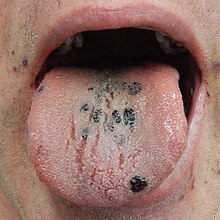Petechia
| Petechia | |
|---|---|
| Other names | Petechiae |
 | |
| Petechiae on the tongue in a person with platelets (platelet count) of 3 G/L (normal: 150–450 G/L) due to ITP | |
| Pronunciation |
|
| Specialty | Rheumatology |
A petechia (/pɪˈtiːkiə/;[1] pl.: petechiae) is a small red or purple spot (≤4 mm in diameter) that can appear on the skin, conjunctiva, retina, and mucous membranes which is caused by haemorrhage of capillaries.[2][3] The word is derived from Italian petecchia 'freckle', of obscure origin.[1] It refers to one of the three descriptive types of hematoma differentiated by size, the other two being ecchymosis (>1cm in diameter) and purpura (4-10mm in diameter). The term is typically used in the plural (petechiae), since a single petechia is seldom noticed or significant.
Causes
[edit]Physical trauma
[edit]The most common cause of petechiae is through physical trauma such as a hard bout of coughing, holding breath, vomiting, or crying, which can result in facial petechiae, especially around the eyes. Excessive scratching and friction, especially on thin and poorly circulated parts of the body may also cause petechiae. Such instances are generally considered harmless and usually disappear within a few days, but depending on severity and frequency may be indicative of an underlying medical condition.
- Constriction, asphyxiation – petechiae, especially in the eyes, may also occur when excessive pressure is applied to tissue (e.g., when a tourniquet is applied to an extremity or with excessive coughing or vomiting).
- Sunburn, childbirth, weightlifting[4]
- Gua Sha, a Chinese treatment that scrapes the skin
- High-G training
- Hickey
- Asphyxiation
- Choking game
- Oral sex[5]
Non-infectious conditions
[edit]- Vitamin C deficiency, scurvy[4]
- Vitamin K deficiency[4]
- Leukemia[4]
- Thrombocytopenia – Low platelet counts or diminished platelet function (e.g., as a side effect of medications or during certain infections) can give rise to petechial spots[6]
- clotting factor deficiencies – (Von Willebrand disease)
- Hypocalcemia
- Idiopathic thrombocytopenic purpura
- Coeliac disease
- Aplastic anaemia
- Lupus
- Kwashiorkor or Marasmus – Childhood protein-energy malnutrition
- Erythroblastosis fetalis
- Henoch–Schönlein purpura
- Kawasaki disease
- Schamberg disease
- Ehlers–Danlos syndrome
- Sjögren syndrome – Petechial spots could occur due to vasculitis, an inflammation of the blood vessels. In such a case immediate treatment is needed to prevent permanent damage. Some malignancies can also cause petechiae to appear.
- Radiation
- Fat embolism syndrome
Infectious conditions
[edit]- Babesiosis
- Bolivian hemorrhagic fever
- Boutonneuse fever
- Chikungunya
- Cerebral malaria
- Congenital syphilis
- Crimean–Congo hemorrhagic fever
- Cytomegalovirus
- Dengue fever
- Dukes' disease
- Ebola
- Endocarditis
- Influenza A virus subtype H1N1
- Hantavirus
- Infectious mononucleosis
- Marburg virus
- Neisseria meningitidis
- Rocky Mountain spotted fever
- Scarlet fever
- Typhus[7]
- Streptococcal pharyngitis – Petechiae on the soft palate are mainly associated with streptococcal pharyngitis,[8] and as such it is an uncommon but highly specific finding.[9]
Forensic science
[edit]Petechiae on the face and conjunctiva (eyes) are unrelated to asphyxiation or hypoxia.[10] However, the presence of petechiae may be used by police investigators in determining whether strangulation has been part of an attack. The documentation of the presence of petechiae on a victim can help police investigators prove the case.[11] Petechiae resulting from strangulation can be relatively tiny and light in color to very bright and pronounced. Petechiae may be seen on the face, in the whites of the eyes or on the inside of the eyelids.
See also
[edit]References
[edit]- ^ a b "Petechia definition and meaning".
- ^ Reyes, Melissa A.; Eichenfield, Lawrence F. (2012-01-01), Long, Sarah S. (ed.), "73 - Purpura", Principles and Practice of Pediatric Infectious Diseases (Fourth Edition), London: Elsevier, pp. 441–444.e1, ISBN 978-1-4377-2702-9, retrieved 2022-08-02
- ^ Gooch, Jan W. (2011), Gooch, Jan W. (ed.), "Petechia", Encyclopedic Dictionary of Polymers, New York, NY: Springer, p. 914, doi:10.1007/978-1-4419-6247-8_14466, ISBN 978-1-4419-6247-8, retrieved 2022-08-02
- ^ a b c d "Causes". Mayo Clinic.
- ^ Schlesinger, SL; Borbotsina, J; O'Neill, L (September 1975). "Petechial hemorrhages of the soft palate secondary to fellatio". Oral Surgery, Oral Medicine, and Oral Pathology. 40 (3): 376–78. doi:10.1016/0030-4220(75)90422-3. PMID 1080847.
- ^ Kumar, Vinay (2017). Robbins Basic Pathology. Abbas, Abul K.; Aster, Jon C.; Perkins, James A. (10th ed.). Philadelphia, PA. p. 101. ISBN 978-0323353175. OCLC 960844656.
{{cite book}}: CS1 maint: location missing publisher (link) - ^ Grayson MD, Charlotte (2006-09-26). "Typhus". MedlinePlus Medical Encyclopedia. National Institutes of Health. Retrieved 2007-11-05.
- ^ Fact Sheet: Tonsillitis from American Academy of Otolaryngology. "Updated 1/11". Retrieved November 2011
- ^ Brook I, Dohar JE (December 2006). "Management of group A beta-hemolytic streptococcal pharyngotonsillitis in children". J Fam Pract. 55 (12): S1–11, quiz S12. PMID 17137534.
- ^ Ely, Susan F.; Charles S. Hirsch (2000). "Asphyxial deaths and petechiae: a review" (PDF). Journal of Forensic Sciences. 45 (6): 1274–1277. doi:10.1520/JFS14878J. Retrieved 2007-09-22.
- ^ "Investigating Domestic Violence Strangulation". BlueSheepdog.com. 2007-11-09. Retrieved 12 May 2011.
